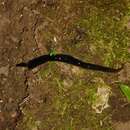en
names in breadcrumbs


Amaga ist eine Gattung der Landplanarien, die in Südamerika beheimatet ist.
Die Gattung Amaga wurde von Robert E. Ogren und Masaharu Kawakatsu definiert. Ihr wurden Landplanarien der Neotropis zugeordnet, die in ihrem Kopulationsapparat eine Penispapille innerhalb ihrer männlichen Geschlechtshöhle haben, genauer eine kleine Penispapille, die am proximalen Ende des gefalteten Atrium genitale sitzt.[1]
Eine neuere Beschreibung der Typusart Amaga amagensis zeigte auf, dass die Penispapille nicht permanent ist. Die Testikel liegen rückenseitig oberhalb der parenchymalen Quermuskeln, während sie bei anderen Arten der Unterfamilie Geoplaninae unterhalb der Muskulatur sitzen. Die Individuen der Gattung haben einen großen, breiten und flachen Körper mit einem drüsenreichen Rand entlang des Körpers, die Drüsen können bei histologische Schnitten erkannt werden. Im weiblichen Bereich des Kopulationsapparats münden die Ovellinkanäle am gleichen Ort in die weibliche Geschlechtshöhle, ohne vorher in einem gemeinsamen Kanal zusammenzulaufen.[2] Bei einer Revision muss evaluiert werden, ob andere Arten der Gattung möglicherweise in neue Gattungen überführt werden müssen.[2]
Der Gattungsname Amaga wurde vom Artepitheton der Typusart amagensis abgeleitet, die als Geoplana amagensis erstbeschrieben wurde. Dieser ergibt sich wiederum aus dem Fundort in der Region um Amagá in Kolumbien.[1]
Die meisten Arten der Gattung Amaga wurden in den Gegenden ihrer Herkunft im kontinentalen Südamerika gefunden. Die Art Amaga expatria wurde auf den Bermudas entdeckt[3], jedoch bisher noch nicht in Südamerika. Im Jahr 2020 zeigte eine Studie ein Vorkommen an mehreren Orten der Inseln Guadeloupe und Martinique.[4] Amaga expatria ernährt sich von Schnecken und Regenwürmern.[4]
Von Amaga expatria wurde das vollständige mitochondriale Genom entschlüsselt. Es hat eine Länge von 14.962 bp und enthält zwölf proteinkodierende Gene, zwei rRNA-Gene und 22 tRNA-Gene. Von den bekannten Genomen anderer Landplanarien weist es die größte Ähnlichkeit zu Obama nungara auf.[4]
Der Gattung Amaga werden zehn Arten zugeordnet:
Amaga ist eine Gattung der Landplanarien, die in Südamerika beheimatet ist.
Amaga is a genus of land planarians from South America.
The genus Amaga was erected by Robert E. Ogren and Masaharu Kawakatsu to include Neotropical land planarians with an intra-antral penis papilla, i.e., a small penis papilla at the proximal end of a folded male atrium.[1]
A recent redescription of the type species, Amaga amagensis, revealed that the intra-antral penis papilla is not a permanent structure as previously thought. A new diagnosis of the genus describes it as Geoplaninid land planarians with a large and broad, flat body and a well-developed glandular margin, i.e., several glands discharge along the margins of the body, which can be observed in histological sections. The testes are located at the dorsum, above the parenchymal transverse muscles, while most species in the subfamily Geoplaninae have dorsal testes beneath the parenchymal transverse muscles. The copulatory apparatus lacks a permanent penis and the ovovitelline ducts enter the female atrium at the same time, without joining to form a common duct.[2] The remaining species currently in the genus need a taxonomic re-evaluation and may be transferred to new genera in the future.[2]
The name Amaga comes from the specific epithet, amagensis, of the type-species, originally described as Geoplana amagensis due to its occurrence in the proximities of Amagá, Colombia.[1]
Most species of Amaga have been found in their country of origin in continental South America. However, Amaga expatria has been discovered in the Bermuda[3] and has never been found in South America. In 2020, a study showed that the species was present in many locations in the islands of Guadeloupe and Martinique.[4] Amaga expatria feeds on earthworms and snails.[4]
The complete mitochondrial genome of Amaga expatria has been analysed.[4] It is 14,962 bp in length and contains 12 protein coding genes, two rRNA genes and 22 tRNA genes. The mitogenome was compared with the few available mitogenomes from geoplanids and the most similar was Obama nungara, a species from South America.
The following species are accepted in the genus Amaga:
Amaga is a genus of land planarians from South America.
Amaga is een geslacht van platwormen (Platyhelminthes) uit de familie Geoplanidae. De wormen zijn tweeslachtig. De soorten leven in of nabij zoet water.
Deze lijst van 12 stuks is mogelijk niet compleet.
Amaga is een geslacht van platwormen (Platyhelminthes) uit de familie Geoplanidae. De wormen zijn tweeslachtig. De soorten leven in of nabij zoet water.